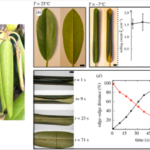Paper, Mechanical basis for thermonastic movements of cold-hardy Rhododendron leaves
Abstract: “The profusion of rhododendrons in cold climates is as remarkable as the beauty of their blooms. The cold-hardiness of some of the montane species is in part due to reversible leaf movements triggered under frigid conditions wherein the leaves droop at the leaf stalks (petioles) and their margins roll up around the midrib. We probe the mechanics of these movements using leaf dissection studies that reveal that the through-thickness differential expansion necessary for leaf rolling is anisotropically distributed transverse to and along the midrib. Numerical simulations and theoretical analyses of bilayer laminae show that the longitudinal expansion amplifies the transverse rolling extent. The curvature diversion scales with the in-plane Poisson’s ratio, suitably aided by the stiff midrib that serves as a symmetry breaking constraint that controls the competition between the longitudinal and transverse rolling. Comparison of leaf rolling with and without the petiole indicates that the petiole flexibility and leaf rolling are in part mechanically coupled responses, implicating the hydraulic pathways that maintain the critical level of midrib stiffness necessary to support the longitudinal expansion. The study highlights the importance of curvature diversion for efficient nastic and tropic leaf movements that enhance cold-hardiness and drought resistance, and for morphing more general hinged laminae.”
Learn about our two Decals!
 Click here to find out more about our Fall Bioinspired Design Decal and our Spring Bioinspired Design in Action Decal – ALL MAJORS are welcome.
Click here to find out more about our Fall Bioinspired Design Decal and our Spring Bioinspired Design in Action Decal – ALL MAJORS are welcome.Berkeley BioDesign Community
 Click here to learn about the BioD: Bio-Inspired Design @ Berkeley student organization or here to signup for more info.
Click here to learn about the BioD: Bio-Inspired Design @ Berkeley student organization or here to signup for more info.Search
Student Login




I imagine that the neurological circuits underlying these processes are governed by both 2d spacing maps with their brains as…
to reduce the impact of car accidents, it may be possible to study the force diverting physics of cockroaches to…
you see this type of head-bobbing stability in many avian creatures related to pigeons like chickens. the head ability to…
not like they taught horses how to run! this is an example of convergent evolution where both sea creatures and…
The brain functions in a similar way with neuronal connections. our brains are able to utilize the multiplicity of connections…